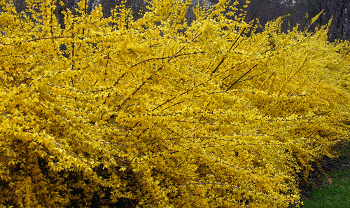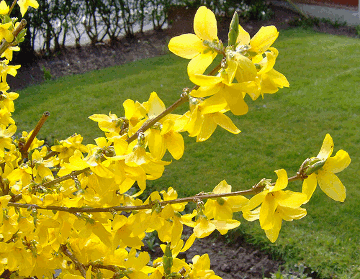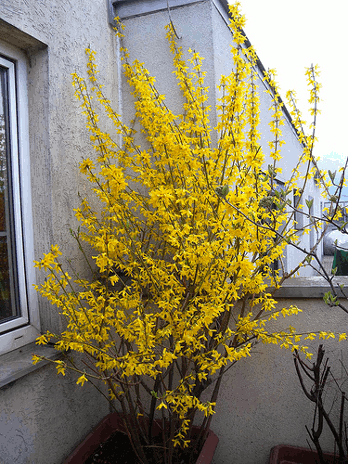Forsythia is a
fast-growing hardy shrub in the same family of plants as the olive tree
(the Oleaceae family). These
attractive bushy plants are known for their abundant yellow flowers
which bloom in early Spring.
Forsythia
plants are deciduous, meaning they lose their leaves
during part the winter. Buds start to form around february in
time for
the flowers to spurt into their yellow blaze in Spring.
The
flowers actually appear before the leaves. The flower buds
grow
individually, or together in the leaf axils of last year's branches.
The forsythia plant grows
upright, splaying out as it increases in
height. As the bushy branches spread out they
can become over-hanging. The
branches themselves are usually hollow. Young
branches can be a little
sharp-edged in cross section. The Autumn color is
sometimes a yellowy to purply red, and other times
simply dark green or
olive
green.
With
their speedy growth, forsythias can increase in size by up to
2
feet per year. They can reach a height of between 1 to 3
metres,
sometimes even achieving a rare height of 6 metres if unpruned.
Uses and Positioning of
Forsythia Plants
They
are a very versatile plant and can be used in lots of different ways.
A forsythia bush can make an excellent stand-alone feature
growing at the centre of your garden, or can be use for
privacy as
a hedge, either neatly trimmed or as a more loosely arranged screen.
With proper training, forsythias can look flat great
in a
flat plane vertically against a wall or fence. Alternatively
with
some creative pruning and shearing they can be shaped into patterns to
produce ball shapes, tree-like structures or many other compositions.
 Picture of
Forsythia Bush
by Dan Zen Picture of
Forsythia Bush
by Dan Zen
Forsythia's
blooms have four petals which connect together at the base to
form
a bell-shaped flower. Their early burst of spring flowers make
this an ideal choice to position in garden next to evergreen
plants. The flowers produce small capsules with slightly
winged
seeds. The fruit of some species is used
in traditional
Chinese medicine. The plant's leaves are a pointed-oval shape
two
to 10 centimetres in size, often serrated at the edges but sometimes
smooth-edged.
Forsythia shrubs attract
relatively few pests. As their flowers do not produce nectar,
they are
perfectly worthless as source of food for
nectar-seeking animals
like bees or butterflies, although they can be home to some
caterpillars
however.
Origins
of Forsythia
There are around 11
different species of forsythia, most of them originating from Eastern
Asia, although one, Forsythia
europaea, originates
from the Balkan areas of Serbia and Albania
in Southeastern Europe. The
main species of Forythia which is cultivated as an ornamental
garden shrub and for hedges is a hybrid know
as Forsythia ×
intermedia.
This is a cross-breed of forsythia suspensa (a mainly drooping
or weepng species) and forsythia
viridissima (a more upright variety).
They
are named after the 18th century botanist, William_Forsyth,
who
was one of the founders of the royal Society of Horticulture of London.
The first recorded live seedling in Western Europe
was introduced to Holland from Japan by
Verkerk
Pistorius in 1833.
Growing Forsythia Bushes
Forsythia
are easy to grow and
not particularly fussy about location or soil type.
As long as the
ground is well-drained, they will usually thrive nicely. The
plants do
appreciate some sun, so don't position them in a permanently shaded
area of your garden. Although they can resist drought, they
shouldn't
be kept too dry - an average climate is just fine for them.
They will
withstand frost so you needn't worry about them over a chilly winter.
New
forsythia bushes can easily be grown from an existing plant, either by
using cuttings or from live ground-lying branches. If
taking cuttings to propagate, it is best to do this during the
dormant
months from December to January. Cut about 5 inches from a new tip, and
place you cutting in moist soil or compost so that it can stand up on
its own. You can start to grow a new plant either indoors or
outdoors. Once a good set of roots has grown, you can then transplant
your forsythia to its final location. You could even grow
forsythia in a container or pot to decorate a stone patio or
terrace.
If
growing a new plant from ground-lying branches from an
existing
bush, ensure that a few inches of the branch is kept covered by soil or
compost. To do this, first cover the branch, then place a
small
rock or stone on top to ensure it stays in place to allow the roots to
develop.
A
forsythia plant will give you years of enjoyment. Keep yours
healthy and vigorous by regularly pruning and you'll be rewarded with a
lifespan of 20 to 50 years for this attractive plant.
Trimming and Pruning Forsythia Bushes

|
|




